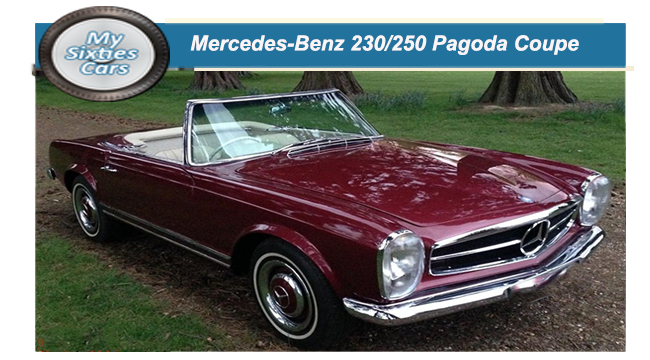
The Mercedes-Benz 230/250 (W111) coupe and convertible were rated as among the most distinctive car designs of the Sixties.
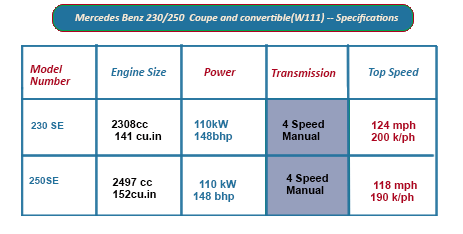 More of a tourer than a sports car, the 230 and 250 went on set the tone for all future Mercedes performance vehicles, single-handedly taking over from both the magnificent 300SL and the 190SL.
More of a tourer than a sports car, the 230 and 250 went on set the tone for all future Mercedes performance vehicles, single-handedly taking over from both the magnificent 300SL and the 190SL.
A cross between the 300SL and the 190SL, the coupe version of the Mercedes-Benz 230 SL and 250SL, launched in 1965, was rapidly nicknamed the "Pagoda" because of its uniquely designed removable hardtop roof, the brainchild of the skilled Austrian engineer Bela Barenyi.
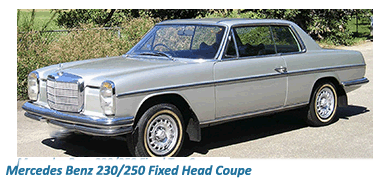 The hardtop’s subtle pagoda shape was not only highly attractive but subtly intended to provide the lightweight roof with additional strength.
The hardtop’s subtle pagoda shape was not only highly attractive but subtly intended to provide the lightweight roof with additional strength.
Behind the 230 and 250, SE’s overall design was French designer Paul Bracq, who had earned himself a reputation during the Sixties for creating some high profile projects.
Among them were a number of custom-built limousines for use by the French presidential cars, as well as being involved in the planning of some important aspects of the TGV high-speed train.
The 230 SE version was powered by a straight-six multi-point 2308cc fuel injected engine while the 2.5 came fitted with a larger 2497cc engine capable of generating 148 bhp and reaching a top speed of 118 mph (190 km/h).
![]()
The coupe and convertible were both available with either a four-speed manual or an automatic transmission option.
The 230SL came fitted with front disc brakes, while the larger-engined 250 (introduced in 1966) had all-round disc brakes and the option of an extra gear. Based on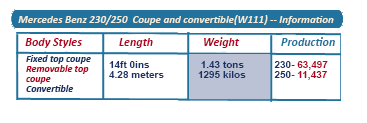 the existing 220 chassis, but with a shorter wheelbase, the 230 and 250 Pagoda coupe featured double wishbone suspension at the front and swing axles at the rear.
the existing 220 chassis, but with a shorter wheelbase, the 230 and 250 Pagoda coupe featured double wishbone suspension at the front and swing axles at the rear.
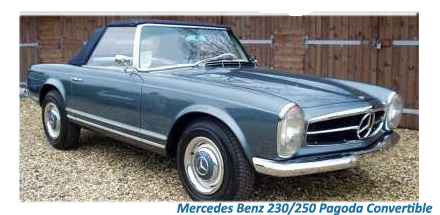 The coupe and convertible variants’ rear end was heavily revised with less dramatic quarter panel fins—a design that was phased out by the end of the decade.
Both the coupe and cabriolet focused on luxury with a lush leather cabin, woodwork, an abundant supply of highly polished metal trim, and optional amenities such as an automatic transmission, power steering, air-conditioning, and a sunroof for the coupe.
The coupe and convertible variants’ rear end was heavily revised with less dramatic quarter panel fins—a design that was phased out by the end of the decade.
Both the coupe and cabriolet focused on luxury with a lush leather cabin, woodwork, an abundant supply of highly polished metal trim, and optional amenities such as an automatic transmission, power steering, air-conditioning, and a sunroof for the coupe.
During that time, just short of one thousand convertible versions of the 230 were produced, making it the rarest of the W111s and a highly sought-after collector’s item.
![]()
The 250SE model had a very short production run, beginning in 1965 and ending just two years later when the 280SE was introduced.
Described in the media as a car designed for people who were interested in arriving at their destination in style, luxury, and comfort the 230 and 250 coupes and convertibles were far from being top sellers in their time. The less powerful and accordingly less expensive 230s sold better, almost at a six to one ratio compared to the 250.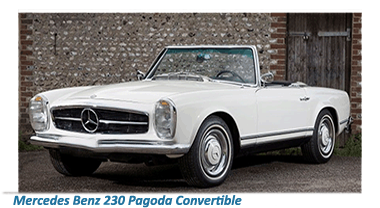 In total, only 5,259 Mercedes 250SE Coupes were built, making them highly sought-after in the classic car market.
Both the 230 and 250s, especially the Pagoda version, had a considerable list of celebrity owners during and after its production run.
These included such Hollywood icons as Charlton Heston, Tony Curtis, John Travolta, and Sophia Loren.
World champion Formula One racing driver Sir Stirling Moss was also a proud owner as well as Beatle John Lennon .
In total, only 5,259 Mercedes 250SE Coupes were built, making them highly sought-after in the classic car market.
Both the 230 and 250s, especially the Pagoda version, had a considerable list of celebrity owners during and after its production run.
These included such Hollywood icons as Charlton Heston, Tony Curtis, John Travolta, and Sophia Loren.
World champion Formula One racing driver Sir Stirling Moss was also a proud owner as well as Beatle John Lennon .






